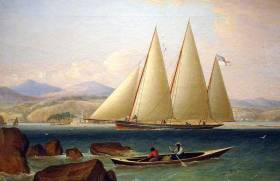Displaying items by tag: gaff
Sailing's Gaff Rig: Ireland's Part in its Downfall
The 35th staging of international races for the 176-year-old America’s Cup is rising rapidly up the agenda. The opening jousts for challengers begin on 26th May 2017 at the first-time-selected venue of Bermuda, and the cup series itself starts there on 17th June. It’s time to focus on the sailing paradise of Bermuda, and particularly its role in changing the shape of sails in mainstream sailing. W M Nixon takes a typically skewed look at what it all might mean.
The irony of it is that, long before the rig was popularly accepted, it was the sailors of Bermuda who were credited with the invention of the jib-headed triangular shape for mainsails. This dominated yacht design for nearly a century. Yet in 2017, as the inevitably trend-setting America’s Cup finally comes to Bermuda for the first time, it will be raced by sailing machines – the word “boats” seems inadequate – which are setting what looks very like an extremely modern variation of the classic gaff rig.
For what are today’s state-of-the-art square-headed mainsails other than an attempt to get as much sail area as possible within the limits set by the height of the mast and the length of the boom? And what rig was based on the same premise? Exactly. The gaff rig, and its very useful cousin, the sprit rig.
 Is this or is this not gaff rig? America’s Cup defenders Oracle in action off San Francisco
Is this or is this not gaff rig? America’s Cup defenders Oracle in action off San Francisco
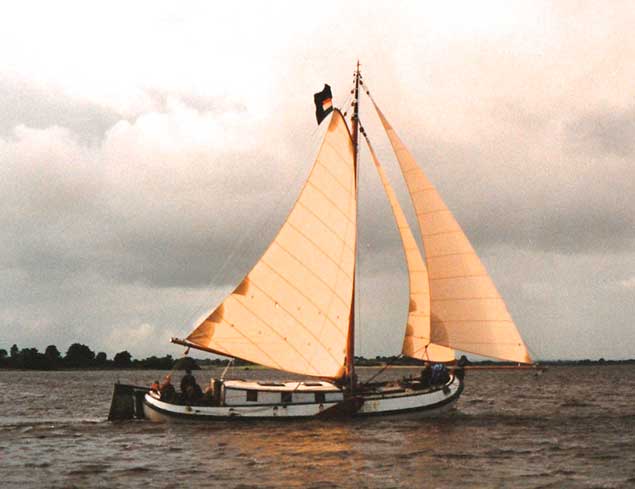 David Beattie’s Dutch Lemsteraak Schollevaer, sailing here on Lough Ree, indicates that classic Dutch yachts tended towards shortening their gaff booms to such an extent that for a period they were almost Bermudan rigged. Photo: W M Nixon
David Beattie’s Dutch Lemsteraak Schollevaer, sailing here on Lough Ree, indicates that classic Dutch yachts tended towards shortening their gaff booms to such an extent that for a period they were almost Bermudan rigged. Photo: W M Nixon
Yet at a certain stage, as the pioneering Dutch yachtsmen moved from the sprit rig to the gaff rig, the gaff booms became so short that the sailing world was very close to having jib-headed mainsails. But boats setting bisquine rig or something very similar showed what could be done with topsails, and longer gaff booms with topsails above them became the norm.
In due course, the logic of having lighter masts, and mainsail and topsail one and the same with no booms between them, became inescapable. Yet because so many people, relatively speaking, had by this time taken up sailing, the arguments about which rig, gaff or Bermudan, was superior soon became ludicrously heated.
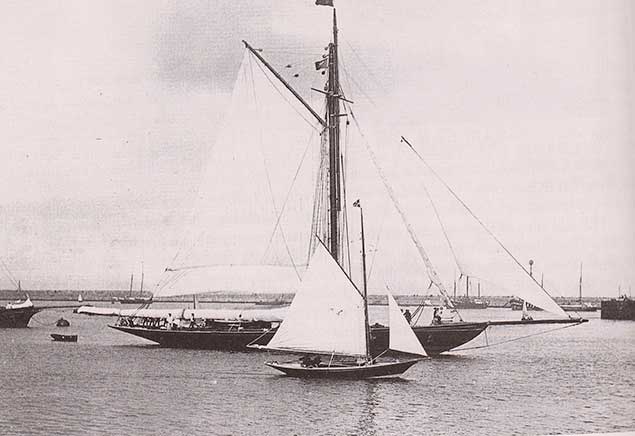 The Prince of Wales cutter Britannia in Dun Laoghaire in 1893, newly-built and on passage from the Clyde to the Solent, showing how a racing gaff rig could be shortened down for sea-going passages in heavy weather, with the topmast safely housed and a loose-footed gaff-headed trisail set instead of the full mainsail.
The Prince of Wales cutter Britannia in Dun Laoghaire in 1893, newly-built and on passage from the Clyde to the Solent, showing how a racing gaff rig could be shortened down for sea-going passages in heavy weather, with the topmast safely housed and a loose-footed gaff-headed trisail set instead of the full mainsail.
Traditionalists argued that while Bermudan rig might be just about acceptable for inshore racing in sheltered water, anyone going cruising or racing offshore needed the rugged gaff rig with its compact mast, possibly heightened by a topmast which could he lowered and housed against the forward side of the mainmast when at sea and conditions deteriorated.
And then there were and still are the uber-traditionalists who argue that if gaff rig had been good enough for their fathers and forefathers before them, then it was good enough for them, and you don’t have to go any further than Howth, Connemara or Falmouth to find them in their droves.
A new factor entered the equation with the development of the heritage industry, which concluded that that the loss of familiarity with handling the formerly-universal gaff rig was a real cultural threat. So in 1963 the Old Gaffers Association came into being at much the same time as the Classic Yacht Movement was starting to gain traction, and thus the preservation of gaff rig was being upheld from both ends of the wealthy to barely-getting-by spectrum.
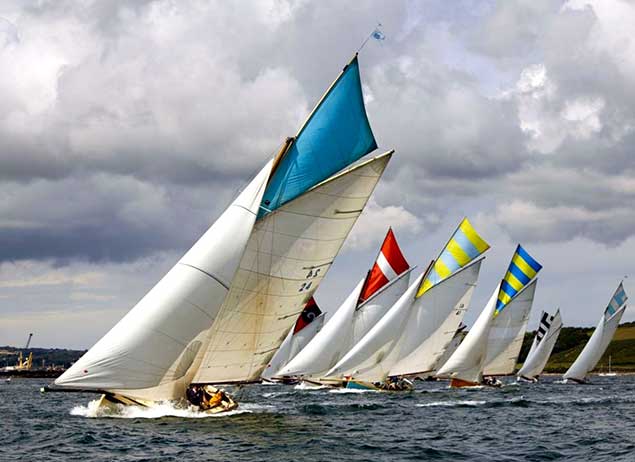 Where gaff rig is the norm – Falmouth Working Boats racing. Under ancient legislation, it is only permissible to dredge for oysters in Falmouth Harbour under sail, and the working boat with adjustable performance has developed as a result.
Where gaff rig is the norm – Falmouth Working Boats racing. Under ancient legislation, it is only permissible to dredge for oysters in Falmouth Harbour under sail, and the working boat with adjustable performance has developed as a result.
It was all great fun if you didn’t take it took seriously, but in its day, some people took it very seriously indeed and a few still do, so we’ll give the pot a very good stir by revealing that it was Irish sailors who played a key role in making Bermudan rig mainstream.
Our header image reveals that Bermudan rig in a quite sophistcated form was not unknown from 1834 onwards. But nevertheless even in crack yachts like Belfast linen magnate John Mulholland’s schooner Egeria of 1865 vintage, and John Jameson of Dublin’s cutter Irex designed by Alexander Richardson in 1884, the relatively crude gaff topsails being set still showed how closely they were descended from lug rigs which in turn had evolved from trying to get simple squaresails to set closer to the wind.
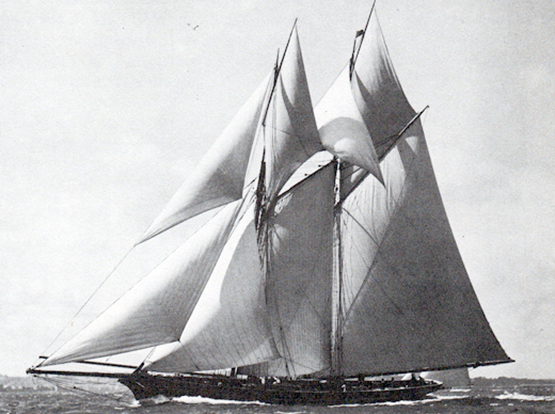 John Mulholland’s 99ft schooner Egeria of 1865 vintage set topsails which were developments of lug sails
John Mulholland’s 99ft schooner Egeria of 1865 vintage set topsails which were developments of lug sails
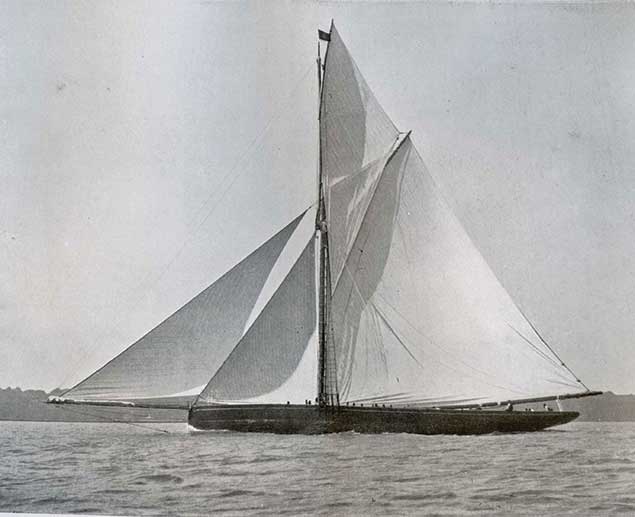 John Jameson’s Irex of 1884 originally set a topsail which looked very out-of-date just ten years later
John Jameson’s Irex of 1884 originally set a topsail which looked very out-of-date just ten years later
But by the late 1880s, topsails were becoming more clearly jib headed, and for a while they used a combination of short mainmast, a short topmast, and a topsail yard to provide their height, which could resulted in a distinctly stunted look when on a dead run, as is seen in the Scottish ironmaster Peter Donaldson’s all-conquering 70ft 40-rater Isolde, designed and built by Fife in 1895.
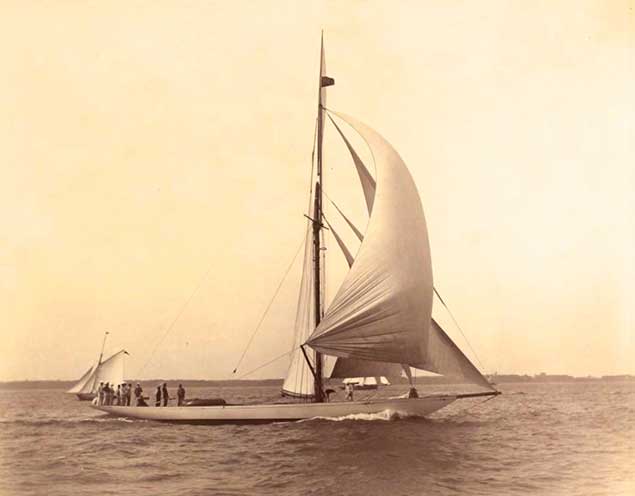 Fast boat, dumpy rig? Peter Donaldson’s successful Isolde of 1895 looked to have a very low-slung rig when she squared off on the run
Fast boat, dumpy rig? Peter Donaldson’s successful Isolde of 1895 looked to have a very low-slung rig when she squared off on the run
It is the famous photo of the new Belfast Lough 25ft One Designs at their start in the RUYC Regatta in July 1898 - their second season – which best shows how gaff rig had developed in the decade since Irex was the boat to beat. The BLOD 25’s have topsails which use long yard to sit as flush as possible with the mast. As the luff length of the topsail was actually longer than the luff length of the mainsail, and as it is luff length which does most of the work in making to windward, getting the topsail and mainsail to set as one was vital in achieving best performance.
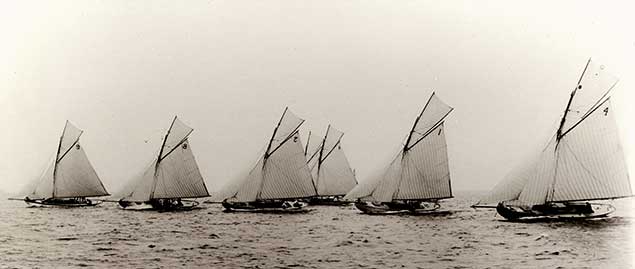 Serious topsails. With a luff length longer than the luff length of the mainsail, the Belfast Lough 25ft ODs had to get the set of their topsails just right.
Serious topsails. With a luff length longer than the luff length of the mainsail, the Belfast Lough 25ft ODs had to get the set of their topsails just right.
In fact, as I learned in my days of racing a Howth 17, fractions of an inch in the location of the topyard halyard and jackyard outhaul on their respective yards made all the difference between having a very effective topsail, and having a heap of rubbish aloft which was only holding you back if the wind freshened on the final leg. You were getting there if, when setting the sails, you could look aloft and see the newly-hoisted topsail set as flat as a board, with even tensions to every corner. This meant that you could ease the mainsail peak halyard just a smidgin to transfer some of the load directly to the topsail, thereby making mainsail and topsail in effect into one sail which happened to have a couple of bits of wood in the middle.
However, despite the favourable impact made by boats such as Isolde and the BLOD 25s, larger yachts tended increasingly to revert to long topmasts in order to make their topsails more effective, and in the most enthusiastic cases, the mastman would be despatched aloft to lace the luff of the topsail to the topmast and the mast itself. This certainly achieved an efficient set for the sail, but was unseamanlike in the extreme, as it totally obviated the topsail’s supposed benefit of being able to reduce sail area aloft in only a few minutes.
Surprisingly enough, it wasn’t until 1912 that designer Charles E Nicholson was allowed by an owner to do away with the cumbersome, eddy-inducing topmast altogether, simply by extending the mainmast in the lightest possible section in a 12 Metre.
Naturally the critics expected the new unfeasibly tall masts to break under the load of the topsails, and some of them did just that. But those tall continuous masts that stayed aloft tended to win races, and so the Marconi mast was here to stay. They were nicknamed “Marconi” masts in acknowledgement of the high aerials required by Italian radio pioneer Guglielmo Marconi (1874-1937), whose mother was a Jameson and whose first radio report of a sporting event was the Royal St George YC Regatta of 1904 in Dublin Bay.
It was only two years after the first Marconi sailing mast appeared in a yacht that the first international racing yacht took the next logical step of making the topsail and mainsail into one, and that yacht was newly-commissioned in 1914 from Fife of Fairlie by an Irish yachtsman, Arthur F Sharman Crawford, Commodore of the Royal Munster Yacht Club on Cork Harbour.
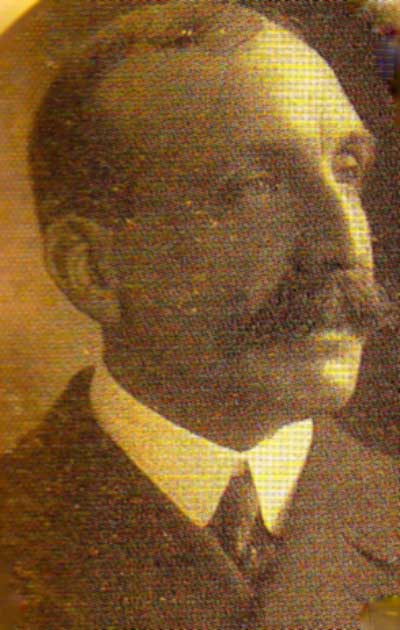 Man of many talents and interests – Arthur F Sharman Crawford contributed much to his adopted home of Cork
Man of many talents and interests – Arthur F Sharman Crawford contributed much to his adopted home of Cork
There’s a book to be written about Arthur F Sharman Crawford (1862-1943), for there’s no way that even a dozen blogs could explain how the Dublin-born English-educated younger son of a northern family with extensive land-holdings in County Down – particularly on the shores of Belfast Lough – came to be the Managing Director of Beamish & Crawford’s brewery in Cork. There, he joined the management team at the age of 28 in 1890, and guided it as Managing Director through some of its most successful periods, and also skillfully negotiated the difficulties of World War 1, the Easter Rising, the War of Independence and the Civil War in a total period from 1914 to 1923, while at the same time being a great benefactor to his adopted city, particularly in the area of technical education, but also in the broader cultural and artistic sphere.
Yet this was no unduly serious do-gooding workaholic. On the contrary, Arthur Sharman Crawford (the family preferred their double surname without a hyphen) was sports mad. A keen yachtsman who was an early owner in the Cork Harbour One Designs of 1896, he was elected Commodore of the Royal Munster YC when it was still at Monkstown in 1898. When it moved to Crosshaven in 1923, as he lived at Lota Lodge in Glanmire north of the harbour, he transferred his full allegiances to the more conveniently located Royal Cork at Cobh where he was already Vice Admiral, and in 1925 he became Admiral and served in that post until 1935.
He also rode to hounds every winter with ferocious enthusiasm, being Joint Master of Cork’s United Hunt for four years. And in later life he played a central role in the establishment of Cork Golf Club, where he served as an actively and frequently-playing President for many years. But in his prime, sailing was his main sport, and he spread his wings far beyond Cork Harbour, for he campaigned on the international scene with a Fife 12 Metre called Ierne, and as a member of many yacht clubs throughout Ireland and Britain, he was a frequent guest helm at regattas, with particularly close associations with the Royal Ulster YC on Belfast Lough.
There, his older brother Robert was Vice Commodore and chaired the committee which oversaw the five challenges for the America’s Cup by Thomas Lipton, the first in 1899 and the last in 1930. The advice of the widely-experienced Arthur was regularly sought by this committee. Yet in other areas of life, there was a parting of the ways between the two brothers. In a time of political restlessness, the northern-based Robert Sharman Crawford was uncompromisingly unionist, and became an active leader in the Ulster Volunteer Force from 1912 onwards. But in the different mood of Cork, the southern-based younger brother had a more accommodating attitude towards Home Rule, reflected in the fact that he continued to play a public role in Cork life, and all his branch of the family were at their deaths buried in the family plot on Little Island in Cork Harbour rather than in the ancestral family lands at Crawfordsburn in County Down.
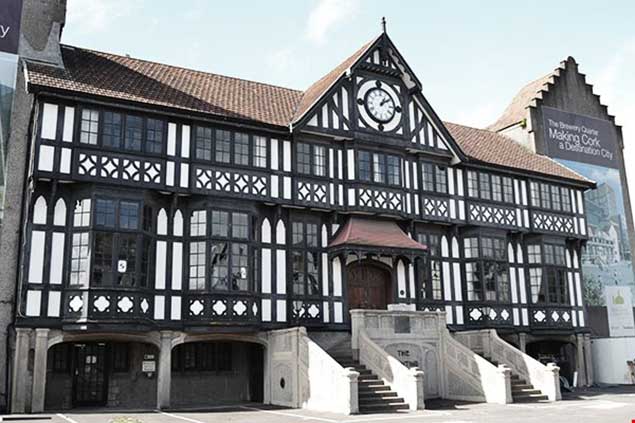 The distinctive Beamish & Crawford Counting House in Cork was built in 1918 during Arthur Sharman Crawford’s long period as Managing Director of the brewery
The distinctive Beamish & Crawford Counting House in Cork was built in 1918 during Arthur Sharman Crawford’s long period as Managing Director of the brewery
There was a very pointed irony in the brothers’ relationship, for even as the brewery in Cork prospered under Arthur’s stewardship, the inherited income from the Crawford estates in the north was shrinking thanks to longterm effects of the activities of Michael Davitt’s Land League and the resultant Gladstone-inspired Land Acts of 1896. The dividends from Cork became an increasingly important part of Robert Sharman Crawford’s income to maintain his opulent lifestyle as a leading yachtsman and as Lord of the Manor of the new loughside Crawfordsburn House, built in the late 1890s to the designs of Vincent Craig. He was the architect brother of Northern Ireland’s future first Prime Minister James Craig (another sailing enthusiast), and his considerable architectural talents were at the same time being deployed for the design of the new Royal Ulster Yacht Club building, which opened in April 1899.
By 1912 and the public declaration of the Ulster Covenant with Robert Sharman Crawford a leading signatory, the fact is that his way of life was largely supported by Beamish & Crawford dividends. It seems only ironic in hindsight – at the time, everyone on all sides though they were doing the right thing. It is only in looking back from the distant and safe viewpoint of 2017 that we realise how curious it was that 104 years ago in 1913, when Colonel Robert Sharman Crawford put his own-funded brigade of the Ulster Volunteer Force through their parades, manoeuvres and exercises on the lawns and fields of Crawfordsburn House, it was all being largely paid for by the continued devotion of the Beamish stout drinkers of Munster.
Yet in that dreamlike pre-World War I era, such activities still seemed slightly theatrical and unreal, and normal life went on at an even more determinedly enthusiastic pace than ever. Having finally agreed a Measurement Rule with the defenders, early in 1914 Thomas Lipton’s latest America’s Cup Challenger, the Charles E Nicholson-designed Shamrock IV, was nearing completion in the south of England. And in the Fife yard in Fairlie in Scotland, a new William Fife designed yacht with an experimental rig was under construction for Arthur Sharman Crawford.
For although Lipton’s technically advanced Shamrock IV carried a very sophisticated gaff rig, it was a gaff rig nevertheless. Thus Arthur Sharman Crawford’s new boat was more important in terms of overall technological development. A more manageable 8 Metre after several successful but demanding years with the 12 Metre Ierne, the new Ierne II was the first yacht to the International Rule of 1907 to set a Bermudan rig.
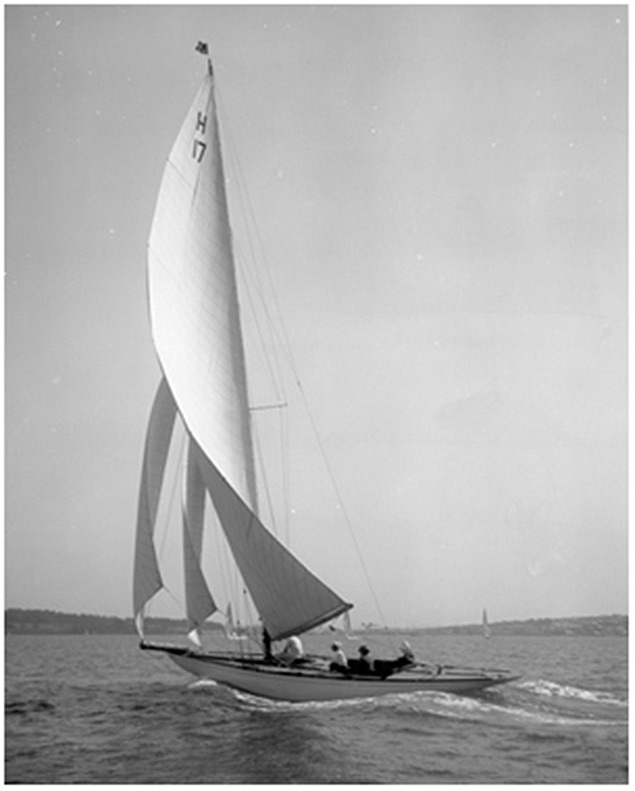 Arthur Sharman Crawford’s 8 Metre Ierne II in 1914, when she was the first International Rule yacht with Bermudan rig.
Arthur Sharman Crawford’s 8 Metre Ierne II in 1914, when she was the first International Rule yacht with Bermudan rig.
Why is she almost totally forgotten in Ireland? Well, Arthur Sharman Crawford led a sort of sailing double life, or even treble life. At home in Cork Harbour, his sailing was local, often using local boats. On Dublin Bay and particularly in Belfast Lough, he was associated with the Lipton camp. But on the Clyde or in the Solent, he was the international or even supra-national yachtsman Arthur Sharman Crawford, challenging the top talents at a rarefied level which was remote from the more localized approach of Cork Harbour or Belfast Lough, and at a tasteful remove from the razzmatazz of Lipton’s America’s Cup challenges.
So when Ierne II appeared fresh out of the wrappers to surprise everyone in the Solent in July 1914, she had never been anywhere near either Belfast Lough or Cork Harbour. It was in the Solent that she made her debut, and for a few very encouraging weeks, while she was undoubtedly a very different creature to sail than a gaff-rigged boat, she was out-performing them all to windward.
It’s intriguing to reflect that when Ierne II was being admired as the hottest new boat in Cowes in late July 1914, briefly in the same harbour at the same time we would have seen Erskine & Molly Childers’ Asgard and Conor O’Brien’s Kelpie pretending to be leisurely cruisers going gently about their business, when in fact they were bound for the Ruytigen Lightvessel to collect their cargoes of Mauser rifles.
Within a couple of weeks, everyone’s plans were in disarray with the outbreak of World War I. All the key figures in the Asgard/Kelpie adventure quickly found themselves positions with the Allied Forces. As for Arthur Sharman Crawford, at the age of 52 this was not an immediate consideration, but his plans for a new programme of fresh excitement for a keen yachtsman past what was then considered the prime of life simply evaporated. Cowes Week 1914 was cancelled completely, and Ierne II was denied the stage which would have provided the setting to enable her to claim her rightful place in sailing history.
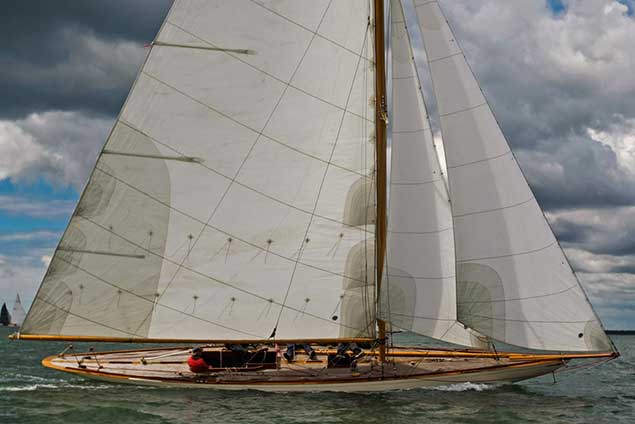 The restored 8 Metre Ierne II is a vivid reminder of Arthur Sharman Crawford’s pioneering instincts.
The restored 8 Metre Ierne II is a vivid reminder of Arthur Sharman Crawford’s pioneering instincts.
Indeed, it was only when noted Yorkshire sailor Hew Jones spotted her laid up in Portugal in 2005 and set about a restoration on Humberside that the whole astonishing story was revealed. When World War II ended in 1918, anyone running a business in Cork amidst Ireland’s growing troubles had other things on his mind, and Arthur Sharman Crawford put Ierne II – laid up since the beginning of August 2014 – on the market. She was eventually bought by Norwegians who wanted a boat for the 8 Metre Class in he 1920 Olympic games in Belgium, and they struck gold in every way, as Ierne II won the Gold Medal.
The top racing sailors were increasingly convinced that Bermudan rig would be where it was at, but in the post war recession, progress was slow. Nevertheless, it was another Irish owner who led the way in the south of England. Elizabeth Workman was the widow of one of the founders of the Workman Clark shipyard in Belfast, and as they at least had done well out of the war, she had the resources to re-commission her 112ft gaff cutter Nyria, designed by Charles E Nicholson and built by Camper & Nicholson in 1906.
Nyria was Solent-based, and following the success of Ierne II and other newly-Bermuda rigged smaller boats in the 1920 Olympics, Elizabeth Workman took the mighty step of getting Charles Nicholson to kit out Nyria with Bermudan rig for the 1921 season, making this the first internationally recognized “big yacht” to do so.
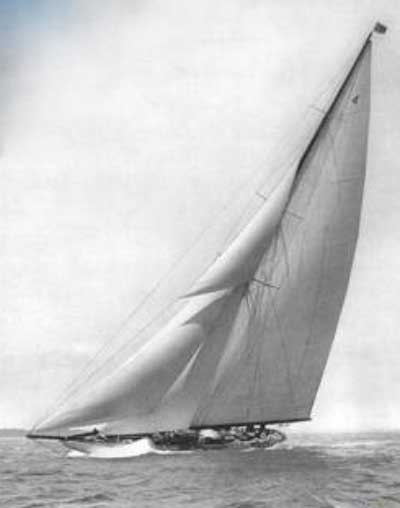 Nyria, owned by Elizabeth Workman of Belfast, in 1921 became the first “big yacht” to be kitted with Bermudan rig
Nyria, owned by Elizabeth Workman of Belfast, in 1921 became the first “big yacht” to be kitted with Bermudan rig
The corner towards Bermudan rig was being turned, and yet another impulse came from Ireland , this time with the commissioning of the world’s first Bermudan-rigged One Design class. The lively Belfast Lough sailing scene of 1914 had been largely destroyed in the trenches of the Somme by the time peace returned in 1918. In an exchange of letters in 1919, some of the more senior members of the Royal Ulster wrote about the need for a new class of boat “which could be sailed by a man and his daughters”. Far from being a gesture for women’s rights, this was simply a sad admission that so many young sailing men would never return from Flanders fields and northern France that it would be 1925 where anything approaching normal manpower levels in sailing would be regained, and so in 1921 the Alfred Mylne-designed Bermudan-rigged 29ft River class made their appearance on Befast Lough. They have never known any rig other than Bermudan, and they continue racing today, though now based on Strangford Lough.
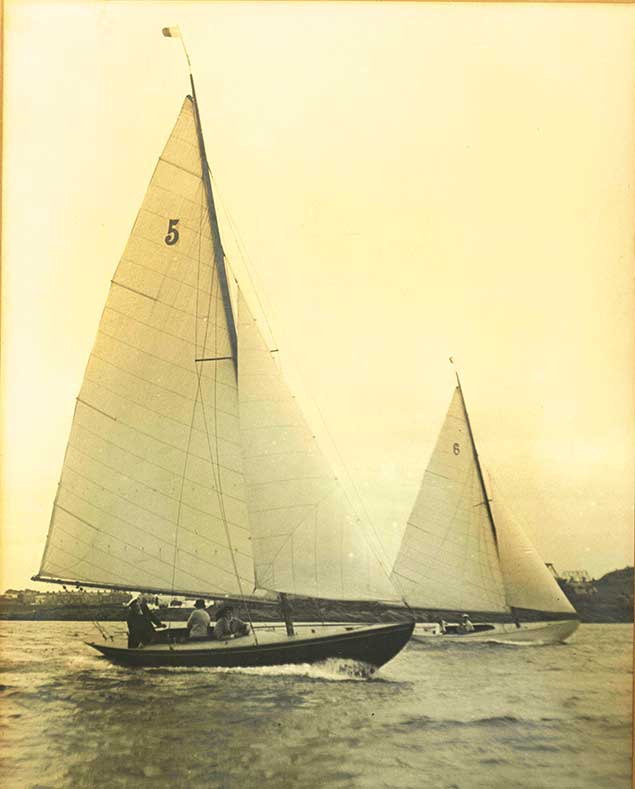 The River Class, seen here racing in Befast Lough in 1921, were the world’s first Bermudan-rigged One Designs.
The River Class, seen here racing in Befast Lough in 1921, were the world’s first Bermudan-rigged One Designs.
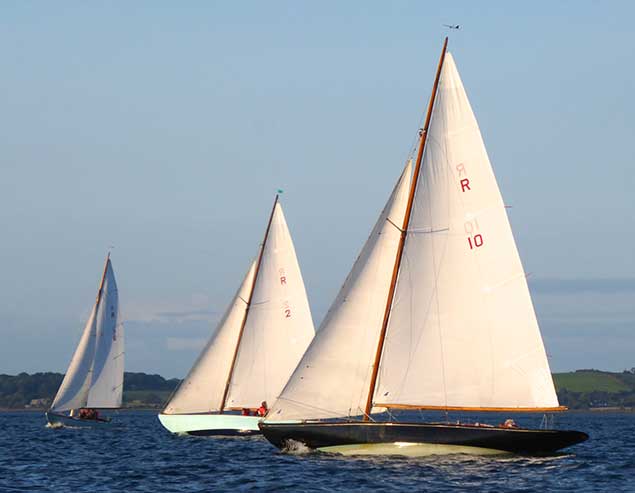 The River Class as they are today in Strangford Lough after 96 years of setting Bermudan rig
The River Class as they are today in Strangford Lough after 96 years of setting Bermudan rig
Thereafter, the move towards Bermuda rig was inexorable and seemingly irreversible, even though sailors as experienced as Billy Mooney of Dublin were ordering the gaff rigged ketch 42ft Aideen to be built by Tyrell’s of Arklow in 1934, and he sailed her so well that he won his class in the 1947 Fastnet Race.
But others were more restless. Since 1898 the gaff-rigged Howth 17s had been sporting their jackyard topsails at their home port north of Dublin, and in 1907 the Dublin Bay Sailing Club adopted the same design, and proprietorially re-designated them as the Dublin Bay 17s. Not only that, but in 1936 a young and competitively successful Dun Laoghaire owner, Terry Roche, decided he would lead the way by converting his DBSC 17 Eileen to Bermudan rig. Despite the fact that she now carried lee helm as he would also have had to move the mast aft to make the new rig balance, he doggedly sailed her to Holyhead and back to prove that all was well. But nobody followed his lead, and after this rather expensive experiment, Eileen reverted to gaff rig and successful racing the following year, and the only lasting memorial of this project is the quaint photo of the Dun Laoghaire waterfront in 1936, a classic image worthy of Cartier-Bresson, with the Water Wags racing off the Royal Irish YC beyond, while in the left of the photo is Eileen sailing under Bermudan rig using mainsail only, which probably balanced quite nicely.
 A quirky photo worthy of Henri Cartier-Bresson. The waterfront at Dun Laoghaire in the summer of 1936, with the Water Wags beyond racing off the Royal Irish YC, and on the left Terry Roche’s Howth/Dublin Bay 17 Eileen in her brief but expensive flirtation with Bermudan rig.Photo courtesy Hilary Keatinge-Roche
A quirky photo worthy of Henri Cartier-Bresson. The waterfront at Dun Laoghaire in the summer of 1936, with the Water Wags beyond racing off the Royal Irish YC, and on the left Terry Roche’s Howth/Dublin Bay 17 Eileen in her brief but expensive flirtation with Bermudan rig.Photo courtesy Hilary Keatinge-Roche
 Howth 17s at Dun Laoghaire again, but this time rigged as nature intended, complete with jackyard topsails. Photo VDLR
Howth 17s at Dun Laoghaire again, but this time rigged as nature intended, complete with jackyard topsails. Photo VDLR
Yet other classes such as the Belfast Lough Island class yawls changed to Bermudan rig in the 1930s, but in Dublin Bay the honour of the gaff rig was stubbornly carried until 1963 by the Dublin Bay 21s, when after sixty years of gaff they converted to Bermudan rig which gave have them another 23 years of active racing life.
Typically of everyone being out of step except Dublin Bay, 1963 was also the very year in which the Old Gaffers Association was founded simply to preserve gaff rig. Ironically, gaff rig is now more visible than ever, albeit above plastic hulls. After all, there are more than a thousand gaff-rigged Cornish Shrimpers sailing the sea.
 Dublin Bay 21 in full gaff rig glory
Dublin Bay 21 in full gaff rig glory
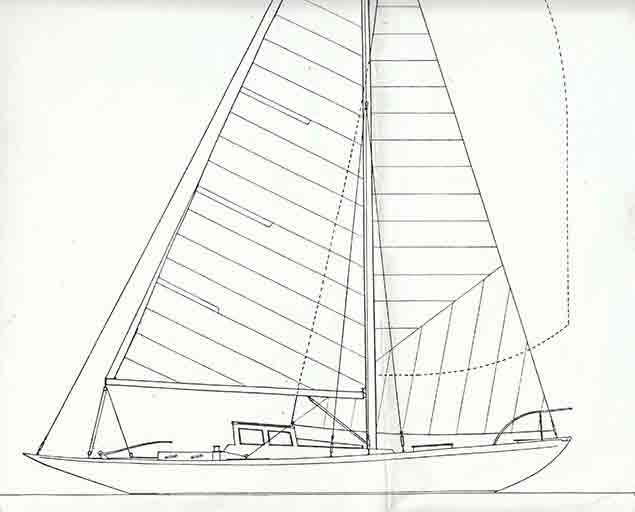 It is 1963, the Old Gaffers Association has just been formed, yet in Dun Laoghaire in 1963 the Dublin Bay 21s make their debut rigged like this……..
It is 1963, the Old Gaffers Association has just been formed, yet in Dun Laoghaire in 1963 the Dublin Bay 21s make their debut rigged like this……..
So is it coming full circle? Maybe. After all, when the America’s Cup multi-hulls start strutting their stuff on Great Sound in Bermuda, they’ll be setting square-headed mainsails which are gaff rig in any sensible definition. And all that where Bermuda rig as we knew it for so long originated more than 183 years ago……
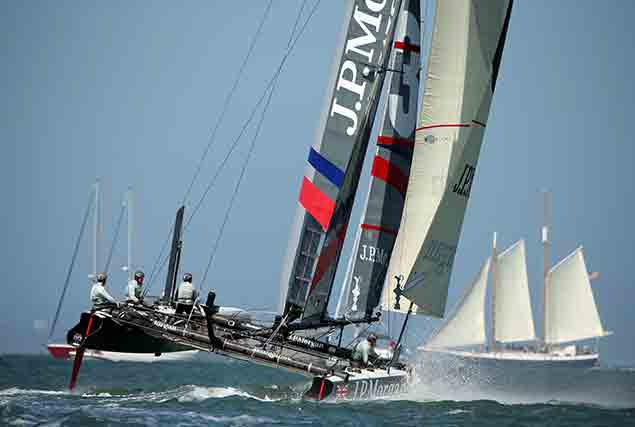 When gaffers meet….one of Ben Ainslie’s America’s Cup boats making knots towards another old gaffer
When gaffers meet….one of Ben Ainslie’s America’s Cup boats making knots towards another old gaffer
But the real test is on Cork Harbour. The reversion to gaff rig came centre stage there last year when the new Ultra National 18s decided the only way to make their otherwise state-of-the-art boats truly sexy was to give them trendy square-topped mainsails.
And if by any chance the spirit of Arthur Sharman Crawford still sails about Cork Harbour, the place he came to love so well, I’ve no doubt he’ll be doing it aboard a ghostly Ierne XXX under a spectral square-topped mainsail, occasionally waxing nostalgic about the old days when he sailed Ierne II with a quaint three-sided mainsail.
 Being fashionable. In 2016, the National 18s Ultras in Cork Harbour reverted to “gaff rig”.
Being fashionable. In 2016, the National 18s Ultras in Cork Harbour reverted to “gaff rig”.
#boatswithcharacter – With the hope that boat numbers will start to increase again as we emerge from recession, categorisation resumes its central place in our thinking about the different types of craft we sail. Yet for a while, when the economy was at its nadir, you could classify your boat in almost any way you liked so long as you at least went out sailing, and kept fleet numbers at some sort of viable level.
But with things now on the move once more, some folk reckon they can afford to become a little more pernickety. For instance, the word is that the Old Gaffers Association may be going to insist that its racing awards can only be won by properly gaff-rigged boats. Yet when they were celebrating their Golden Jubilee in 2013 when the times were very thin indeed, some venerable but Bermudan-rigged craft were allowed to have a meaningful role. And if this was queried by some pedant, the official response was that they were actually setting gaff mainsails which just happened to be three-sided, and this was only as a temporary measure in response to the straitened times......
Quite so. But W M Nixon reckons that in the end, regardless of a boat's alleged type, it is character that is the final arbiter of quality both in the boats and their owners. In an exploration of this, he takes us on a virtual voyage from the Isle of Man to Achill Island, taking in some varied boat festivals on the way.
With boats as with people, it's character that counts. There are those of us who'd reckon there's more character in a battle-scarred all-plastic Cookson 50 than in a contemporary all-wood clinical re-creation of the design style of a previous era for what is known as "The Spirit of Classics" division. Though even here, the boats can begin to get some interesting character if they manage to get roughed about a bit - too much perfection is not good for the soul.
So give us a rough diamond any day, and in unusual boats, as with their owners, the waters around Ireland and nearby places have an abundance of them. One real diamond geezer is Joe Pennington from Ramsey in the Isle of Man. It always makes things that bit more right with the world when Joe comes into port with his workmanlike Manx longliner Master Frank, for Master Frank looks right, and is right – this is classic traditional, gold standard.
So it's ironic that although Joe is one of the Isle of Man's great sailing ambassadors, he's actually from north Lancashire. But he ended up working in the island as a carpenter, and failed to get off. The island, that is...As for his carpentry skills, they were up-graded to shipwright level, but he kept going as a carpenter as there was plenty of work around houses, while at same time restoring the Albert Strange yawl Emerald for his own use.
As he was based in Ramsey in the north of the island, he was very aware that it was the home port of the the last surviving Manx longliner, Master Frank built in 1895, the rapidly deteriorating example of an almost extinct species mouldering away in that very tidal harbour. People had realized the old boat's importance so much that the Manx government had been persuaded to buy her. But as with the Asgard in Ireland in the 1960s, the government may have bought her, but then they hadn't a clue what to do with her.
So one fine day, so the story goes, Joe in his working overalls marched into the Manx parliament, the House of Keys in Douglas, and berated the members for their neglect of this priceless example of the island's maritime heritage. They were flummoxed. So when he then offered to take on full responsibility for the Master Frank if they'd sell her to him with all rights for just one pound, they agreed, as enough was known about what he'd done with the Emerald to convince the assembly that this was their one last and best chance.
Restoring the Master Frank was in effect a re-build, and we have to remember that Joe was working fulltime in his day job as a carpenter. Yet he set himself a work schedule which gives you some idea of his depth of character. Many of us know Joe as a gregarious party animal. And as his appearance is something of a mixture between a gypsy king and the dangerous younger brother of a Roman Emperor, he certainly looks the part. But in order to bring the Master Frank back to life, he took the lonely route of coming home each evening after a day's work, having his tea, and then heading out that night for what was in effect another full day's work, but this time on the boat.

Most of us know Joe Pennington as a gregarious party animal, as seen here in the Peel S & CrC in the Isle of Man with Dickie Gomes of Ainmara and Stu Spence of Madcap.....Photo: W M Nixon
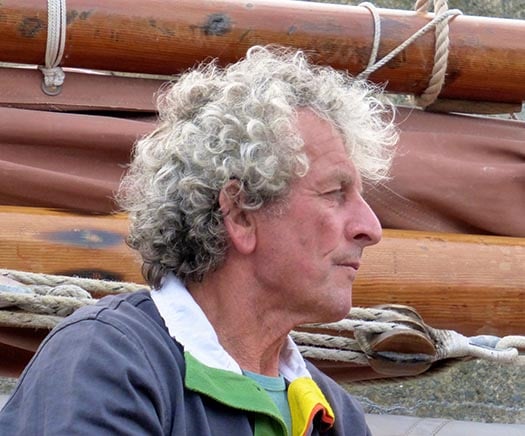
....but there's a serious and determined side to him, and he was just the man to save the very special Master Frank from extinction. Photo: W M Nixon
Night after night, week after week, the project went on, and when Master Frank was re-born, it was utterly worth the effort. Though she's only 36ft in overall hull length, she has the spirit of a much larger vessel, and her character is such that when she turns up at some assembly of classic and traditional craft, the event is a success even if only half a dozen other boats are taking part.
Just how much we'll see of her in Ireland this summer is in the lap of the Gods, as Joe likes to do a lot of cruising with his beloved boat, and Brittany calls. Master Frank is comfortable at sea, though like many workboats her actual hull freeboard is quite low – it's only the high bulwarks which seem to give her plenty of clearance.
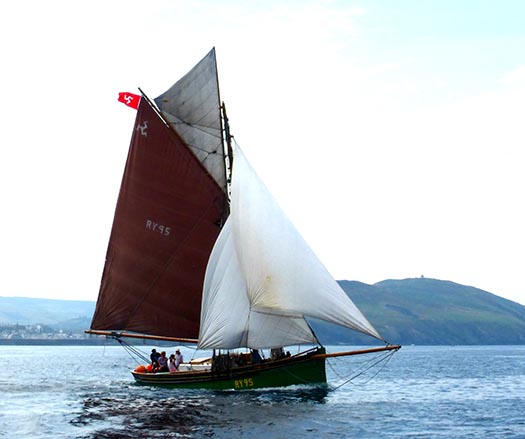
Even in this light breeze off Peel in the Isle of Man, the restored Master Frank shows her class. Photo: W M Nixon
Thus it's normal to have some water on deck when the going starts to get brisk, and this is a characteristic also seen on the famous former pilot cuter Jolie Brise. The noted photographer Brian Carlin captured this to perfection when Jolie Brise went out to the Fastnet Rock during the Glandore Classics in 2013, which happened to be the old pilot cutter's Centenary. She went round in style, but there was no lack of water on deck, and we are reminded of the designer Jack Laurent Giles' comments. After crewing offshore on Jolie Brise when he was still a trainee naval architect, his assertion was that in anything over Force 3 on Jolie Brise, you needed to wear your seaboots, but presumably you were otherwise perfectly comfortable until Force 8 or thereabouts.
 Low freeboard and heavy displacement mean water on deck, but the famous Jolie Brise is otherwise comfortable as she rounds the Fastet to celebrate her Centenary in 2013. Photo: Brian Carlin
Low freeboard and heavy displacement mean water on deck, but the famous Jolie Brise is otherwise comfortable as she rounds the Fastet to celebrate her Centenary in 2013. Photo: Brian Carlin
But while workboats like Jolie Brise and Master Frank needed low hull freeboard with high bulwarks to help them fulfill their allotted tasks, the hookers of Galway Bay were primarily people and cargo carriers, thus they have ample freeboard and are notably dry on deck. But as with the old longliner and the old pilot cutter, at crucial times in their histories the Galway Hookers have needed some determined characters working on their behalf to survive in any shape or form, and while their fleet numbers are now well up, there have been times when they seemed on the brink of extinction.
This was particularly the case in the 1960s. These days we know Dennis Aylmer of Dun Laoghaire as an ever-young senior sailor who relishes his time aboard his neat Cornish Crabber Mona. But the reality is that, more than most, Dennis has earned the right to relax with his "plastic fantastic". For in 1964 and 1965, having toured Connemara as a decidedly impecunious and very young man on his bicycle and then on a tiny motorbike searching for an authentic Galway hooker, he bought the big Morning Star at Tierna on Gorumna Island, and somehow found the resources to have her restored to basic seaworthiness, and then he brought her back to Dun Laoghaire.
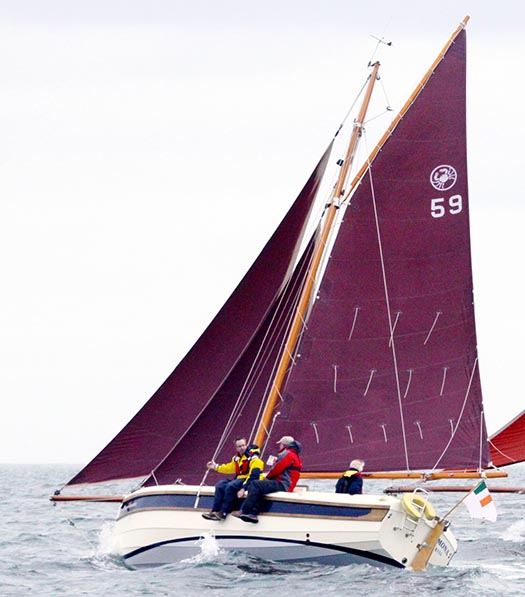
Traditional boat veteran Dennis Aylmer racing his very manageable Cornish Crabber Mona. Photo: Dave Owens
Though there were those who helped the young Aylmer in keeping the Morning Star going, in truth Dun Laoghaire in the 1960s was not a sympathetic environment for rough old gaff-rigged wooden craft. The Dublin Bay 21s had recently converted to Bermudan rig, and fibreglass was in the ascendant, with what amounted to the nucleus of a class of van de Stadt designed 36ft Excaliburs, which had a minimum of timber anywhere in their makeup.
And as work took her owner away for long periods, Morning Star's survival depended on the kindness of others. But somehow she stayed together one way or another until Johnny Healion took her over and gave her a mighty restoration for 1976 which, even on the shores of Galway Bay, was acknowledged as the initiative which led to a reversal in the decline of the old boats.
At one stage there was quite a fleet of restored Galway Hookers of all sizes in the Dublin area and along Ireland's East Coast, and they used to put in their most spectacular appearances at the Portaferry Traditional Boat Regatta in late June (this year's is 26th to 28th June 2015).
But two developments have seen the Galway Hookers' centre of gravity move very positively back to the west. The proliferation of marinas along the east coast is not bowsprit-friendly – old gaffers need a lot of pontoon length and ample manoeuvring space. And the M4 and the M6 have arrived. With Dublin coastal traffic being what it is, thanks to the motorway across Ireland to Galway, tradboat enthusiasts can get to gaffer Nirvanas like Kinvara almost as quickly as they can get to Dun Laoghaire or Howth, and they're more surely among kindred spirits when they get out west.
So although the most sacred gathering of the Galway Hookers is off Connemara at St MacDara's Island on the Saint's day, July 16th, the fleet of traditional boats around Galway Bay is really only up to full power with Cruinniu na mBad at Kinvara, which this year is August 14th to 16th.
The way that Kinvara's natural harbour is shaped, with the hospitable village and its quays at the head of a narrowing inlet which runs north and south to conveniently facilitate boats racing in the prevailing westerlies, means that this is one of the few places where sailing can comfortably become a spectator sport, and the badoiri revel in the close quarters challenges which Kinvara offers.
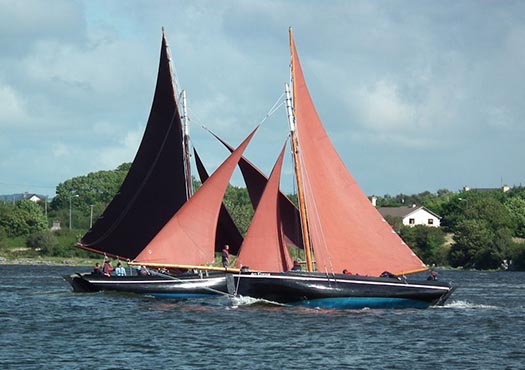
Close quarters Galway Hooker racing at its most visible – it can only be Kinvara.
However, the place becomes so crowded on the festival weekend that you might like to get your required ration of traditional boats elsewhere. But the problem is that while the sailors just want to get on with sailing among other like-minded souls on ancient craft, the organisers are usually in the numbers game, and they want to pack the pierheads and fill the vantage points with avid spectators.
It's all a long way from the long hours of solitary work which have gone into the maintenance of old boats, for which it's said the three essentials are a friend with a low-loader, a hayshed out the back of the house, and a very tolerant wife. Yet those are only the most basic requirements. When you see a gathering of traditional and classic boats in all their finery, what you're seeing is the coming together of people of real character who have had a dream, and they've stayed with it.
And if you're there at the local sea festival time, it will give you added insight into the neighbourhood. You'd be busy every summer weekend if you went with every sort of classic boat assembly, whether sailed, rowed or paddled, but if we just stick with the sailing, we find that there's a pattern which can indeed take us from the Isle of Man to Achill, and many places north and south of them as well.
They start early at Baltimore in West Cork, which could reasonably claim to be the headquarters of diversity in traditional craft, and this is celebrated from May 22nd to 24th this year with the Baltimore Wooden Boat Festival.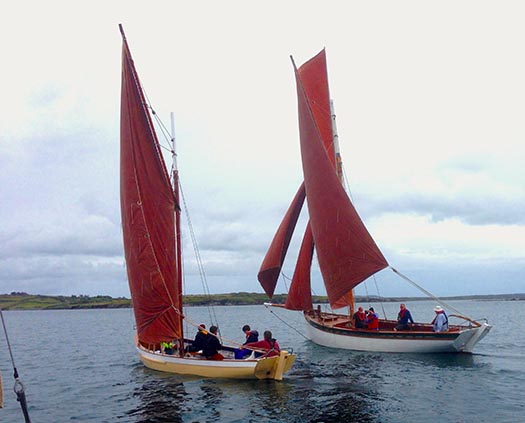
West Cork types will be much in evidence at the Baltimore Wooden Boat Festival from May 22nd to 24th. This is a classic mackerel yawl with a lobster yawl
Then the Dublin area is busy at the end of May and early June, with the DBOGA Riverfest from Poolbeg from May 30th to June 1st, while six days later, the long-established Lambay Race at Howth on June 6th now has a significant classic input with the 117-year-old jackyard topsail-setting Howth Seventeens being joined by both Old Gaffers and Classics.
Inevitably, choices have to be made as the season gains momentum, and the final weekend of June sees both the Portaferry gathering as already mentioned, and the Cobh Traditional Boat Festival on Cork Harbour from June 26th to 28th, with "traditional" naturally taken to include the 1895-vintage Fife-designed Cork Harbour One Designs.
The CHODs will also be starring in this year's main event, the Glandore Classics from July 18th to 24th. This shows every sign of being the biggest Glandore Classic Regatta ever, as the fleet will include a substantial number of Old Gaffers in the early stages of an OGA three week cruise-in-company from Kinsale to West Kerry, while the sailing will be something of a Fife Festival, as the CHODs will be sharing the same racing waters as the visiting Fife ODs from North Wales.
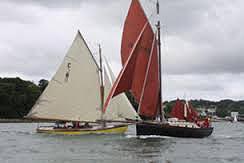
Cork Harbour One Design and Heard 28 Tir na nOg (Sean Walsh) managing to avoid each other at the Glandore Classic Regatta 2013.

Fife OD from the Menai Straits racing at Glandore Classics. Thanks to their wide side-decks, they can sail at an angle of heel unimaginable in most small keelboats, and some helmsmen reckon that the immersed lee deck provides useful lateral resistance
A notable feature of the North Wales Fifes is their wide side decks, which enable these pretty boats to heel a long way without taking water into the cockpit. In fact, it's said that some Fife helmsmen from the squally home waters of the Menai Straits reckon that if they heel their boat enough, the lee deck becomes a sort of secondary keel, and provides significant lateral resistance to enable them to continue to make to windward at an angle of heel which would have any other boat either sinking, or completely out of control, or just sliding sideways out of the picture altogether.......
Make of that what you will, but as we move on round the coast we find that currach racing becomes the dominant passion until the home waters of the Galway Hookers are reached, with the single exception of the one shining star, the Shannon Hooker Sally O'Keeffe at Kilrush, community-built at Querrin on the Loop Head Peninsula, and as sweet a little cutter as you'll see anywhere. Then on north, and we're into Galway Bay with each little port well filled with its quota of bad mor, leath bhad, gleiteog and pucaun.
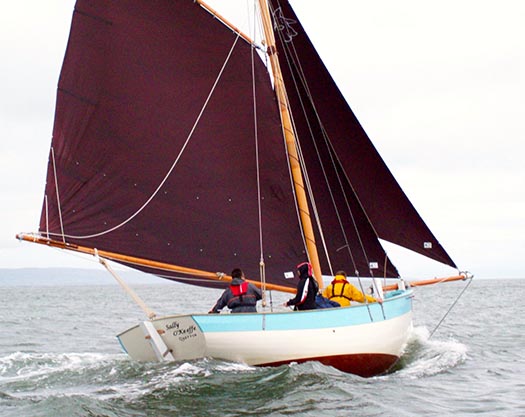
The sweetest thing in the west – the Shannon Hooker Sally O'Keeffe of Querrin on the Loop Head Peninsula
But what, you might well say, was all this about Achill Island? Well, there is a distinct species of local vessel in Achill Sound known as the Achill yawl which, with a single-sail lug rig which is almost a lateen, has a distant relationship to the classic Galway Bay pucaun.
But they have their own way of doing things in Achill Sound. At the peak of the boom years, every pub along the Sound, and local men who had done well in business abroad, between them supported a substantial fleet of Achill yawls which were raced in high summer and early Autumn with a ferocity which was astonishing even to sailmaker Des McWilliam of Crosshaven.
Heaven knows but Des has had enough experience of ferocious racing at all levels of the sport in all sorts of places. But when he went to far Mayo with a new set of threads for a keen Achill yawl owner, naturally as a diligent sailmaker he went afloat for a trial race, and came away suitably chastened by it all.
"We're just big pussy cats in Cork Harbour by comparison with Achill Sound" he reported. "In Achill racing" said he, "they take no prisoners". Yet even the hard men of Achill Sound had to ease back on their enthusiasms when the construction industry fell off a cliff. But just last September, crossing Achill Bridge, I spotted a bit of launching activity. It looks as though Achill yawl racing is showing signs of life again. But it won't be for the faint-hearted.
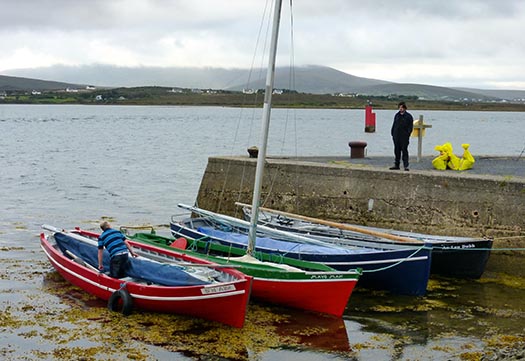
Achill yawls come in several shapes, and the most successful is not necessarily the fastest-looking. Photo: W M Nixon
Dublin Bay Sailing Partnership Based on Artistic Endeavour
#iris – It has been said that keeping a boat-owning partnership intact is much more difficult than maintaining a marriage in a healthy state. Thus for most of us with the boat-owning vocation, sole ownership is the only way to go. But for others, in order to defray costs, increase boat size, and maybe leave more personal time free to pursue other interests, the ambitions can best be realised through one of a wide variety of partnerships and syndicates.
These can go through an extensive range, starting at one extreme with what amounts to time-sharing, with the large number of owners meeting (if they meet at all) only once a year for a sort of Annual General Meeting. Other possible setups can mutate through various arrangements where there is considerable overlap between the boat uses by the different owners, right through to the other extreme of total partnership where all owners sail together as often as is possible.
In some cases, the additional social glue of special shared interests is needed to give the partnership that essential extra vitality. There's nothing new in this. W M Nixon takes a look back a hundred years and more to a boat-owning group whose shared interest in art kept a 60ft ketch on a regular cruising programme around Dublin Bay and the nearby coastlines.
The 60ft gaff ketch Iris had a chequered career. She started life at the peak of the Victorian era in the 19th Century as a naval pinnace serving Dublin Bay, and she was presumably driven by steam. At the time, Dun Laoghaire – then known as Kingstown – was becoming the height of fashion as a naval port of call in the summer, made even more so by its convenient access to the centres of power in Dublin, and its strategically useful direct rail connection – pierhead to pierhead – to the main Royal Navy base in Ireland at Cobh on Cork Harbour.
However, as Kingstown had initially been planned solely as a harbour of refuge – an asylum harbor - for ships in distress in onshore gales, with the actual spur to its construction (starting in 1817) being the wrecking of a British troopship with huge loss of life at Seapoint on the south shore of Dublin Bay, the plans had included no provision for convenient alongside berthing for ships.
Indeed, you get the impression that the original underlying thinking was that there should be as little social contact as possible between ships sheltering in the new harbour and any inhabitants of its nearby undeveloped shore. But the rapid if somewhat chaotic growth of the makings of a new harbourside town, plus the advent of more rapid access from Dublin with the coming of the railway in 1834, soon meant that the top brass expected to be able to get off and on their ships in the harbour in style and comfort, and their Lordships of the Admiralty did not stint in providing large pinnaces for them to do so. When these pinnaces were replaced in due course by even more luxurious vessels, those shrewd amateur sailors who could visualise the older boats' potential as re-cycled government surplus found themselves looking at a bargain.
The Iris was originally built with lifeboat-style construction of double-diagonal hardwood planking, which was quite advanced technology for the time. For the can-do boatbuilders of the late 19th Century, converting such totally purpose-built craft into some sort of a yacht was all part of a day's work. Another similarly-built if smaller and different-shaped vessel, Erskine Childers' Vixen on which the Dulcibella of The Riddle of the Sands fame was based, was formerly an RNLI lifeboat with the standard lifeboat canoe stern. She was made more yacht-like by the addition of a staging aft to compensate for the absence of deck space just where you most need it, while underneath this new permanent staging, additional supporting planking was faired into the hull and – hey presto – you've a yacht-like counter stern.
Vixen also had a massive centre-plate complete with its huge casing, and carried more than three tons of internal iron ballast, all of which left little enough space for living aboard during the long and often rough cruise through the Friesian Islands which provided much of the on-the-ground material – and we can mean that in every sense – on which The Riddle was based.

Erskine Childers' Vixen (on which "Dulcibella of The Riddle" was based) in one of his last seasons of ownership in 1899. At first glance, she looks like a typical old-style cruising cutter of her era. But somewhere in there is a classic canoe-sterned RNLI lifeboat hull to which an afterdeck on a counter stern have been fitted as an add-on.
That cruise was in 1897, and shortly after it was completed, Childers went off to serve in the Boer War. This experience left him with doubts about the validity of the British Imperial mission, but equally left him in no doubt that on active service, there were no medals for enduring unnecessary discomfort. So by the time The Riddle of the Sands was published in 1903, Vixen was sold and he'd become a partner in a much more comfortable cruising boat, the yawl Sunbeam, which in turn was followed in 1905 by his very comfortable dreamship Asgard
Meanwhile, with the Iris a fifteen or so years earlier in Dublin, the conversion to a comfortable sailing cruiser was a more straightforward affair, as she'd a more versatile hull shape with a broad stern in the first place, and her new owner was one George Prescott, an innovator bordering on genius. He was an optical and scientific instrument maker, an electrical engineer and inventor, and a state-of-the-art clockmaker.
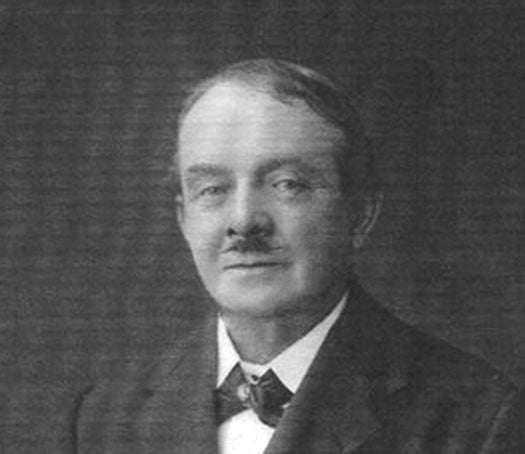
Man of many parts – the polymath George Prescott. Organising the Graphic Cruising Club and running its club-ship Iris was only one of his many interests. He led a long and extraordinarily interesting and varied life, and was nearly a hundred years old at the time of his death in 1942. Courtesy Cormac Lowth
But that was only one part of his life, for he had many friends among Dublin artists, particularly those interested in maritime topics, and he soon found himself to be the secretary of the Graphic Cruisers Club for sailing painters and sketchers, with the Iris becoming the base of their waterborne creative and scientific expeditions on the coast of the greater Dublin area.
She was ideal for this. She'd been converted for sailing with an orthodox gaff ketch rig, while her roomy hull was internally re-configured to have a galley with a large stove right aft, a huge saloon immediately forward of the galley to be both the clubroom and dining room, and sleeping quarters port and starboard in pilot cutter style forward of that.
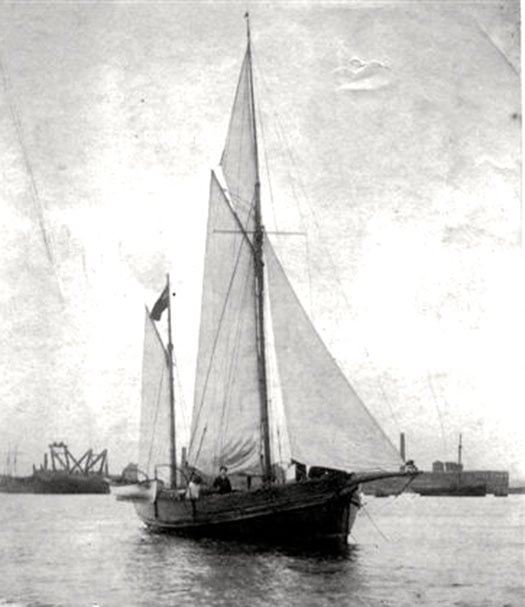
Quite a transformation for a former steam-powered naval pinnace. The 60ft ketch Irish in her heyday as the club ship of the Graphic Cruisers Club in the 1890s. She is at her home anchorage off Ringsend, while across the Liffey a couple of Ringsend trawlers are lying in the roadstead known as Halpin's Pool, where the Alexandra Basin is now located. Photo courtesy Cormac Lowth

Accommodation profile of the Iris in her days as the floating HQ of the Graphic Cruisers Club – this sketch by Alexander William first appeared in The Yachtsman magazine in 1894.
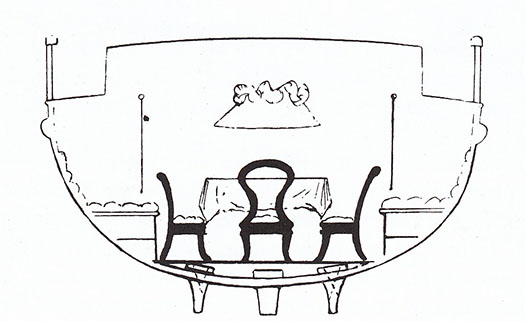
Hull section of the Iris at the saloon, showing the bilge keels which enabled her to dry out comfortably in some some little-known tidal anchorages in the Greater Dublin area.
But underneath the hull, the temptation had been resisted to add a deep keel, and instead the Iris was fitted with substantial bilge keels at the same depth as the shallow keel itself, such that in all she drew only about 3ft 6ins, and would comfortably dry out in a snug berth anywhere that her artistic crew felt they might find subjects worthy of their attention.
Thus she might overnight serenely on the beach at Ireland's Eye or far up the estuary at Rogerstown, and if the Graphic Cruisers Club attention was turned towards County Wicklow, she could comfortably take the ground in Bray or in other little ports inaccessible to orthodox cruising yachts. Yet the claim was that despite the odd arrangements beneath the waterline, she handled remarkably well on all points of sailing, and certainly as she no longer had any sort of engine, she must have sailed neatly enough to get out of some of the confined berths into which her eccentric crew enjoyed putting her.
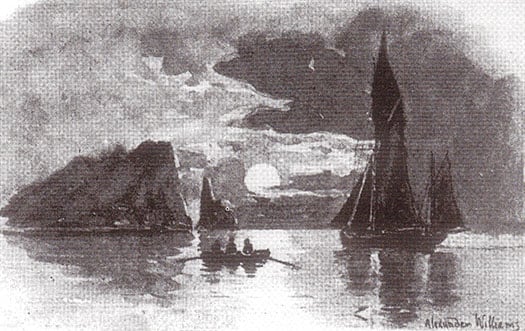
The Iris in gentle cruising mode off Ireland's Eye as the moon rises – this was sketched by Alexander Williams for The Yachtsman in 1894.
George Prescott seems to have been happy to claim that Iris was a club-owned yacht, but in truth most of his shipmates were impecunious artists of varying talent, so it was his generosity and understated business ability which would have kept the partnership together.
However, it really did seem to function as a partnership, for after the Iris project had been up and running for nearly a decade, he turned his attention in 1896 to building an unusual house on the waterfront on the Pigeonhouse Road in Ringsend, which he happily acknowledged to be the clubhouse of the Graphic Cruisers Club even if he lived in it himself.
Called Sandefjord for some reason which is still unexplained, it looked not unlike a smaller sister of the Coastguard Station next door, complete with a lookout tower. And it's distinctly nautical within, as much of the interior includes fine panelling which came from the wrecked Finnish sailing ship Palme, with the stairs being provided by the old ship's main companionway.
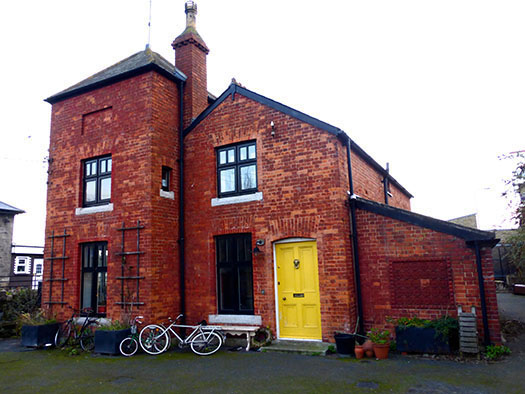
The house called Sandefjord near Poolbeg Y & BC as it is in 2015. When built by George Prescott in 1896, it faced across the Pigeonhouse Road directly onto the waterfront, and overlooked the summer anchorage of the Iris. Photo: W M Nixon
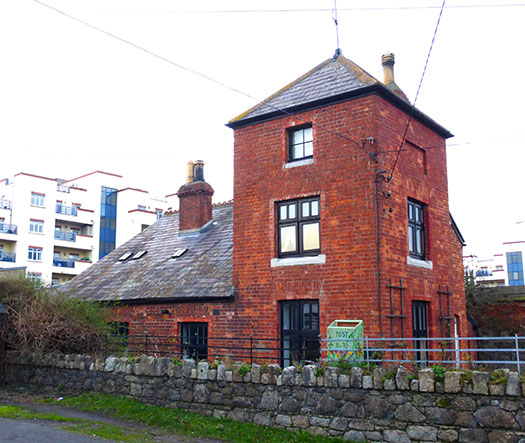
The design style of the Graphic Cruisers Club shore HQ at Sandefjord reflected the lookout tower of the old Coastguard Station next door. Photo: W M Nixon
The house has been restored to become a family home in recent years, and it really is an extraordinary piece of work to come upon on the slip road down to Poolbeg Yacht & Boat Club. Meanwhile, interest in the doings of the Graphic Cruisers Club has been restored by the formidable research talents and tenacity of Cormac Lowth, who single-handedly does more work in uncovering unjustly ignored aspects of Dublin Bay's maritime life in all its variety than you'd get from an entire university department.
I first came across a reference to the Graphic Cruisers Club years ago in an article in an 1894 issue of The Yachtsman magazine, written by Alexander Williams (1846-1930), who was probably the club's most accomplished marine artist. But that was then, this is now, and it has taken Cormac Lowth's dedication in recent times to get the extraordinary setup around George Prescott and Alexander Williams and their friends and shipmates into the proper context.
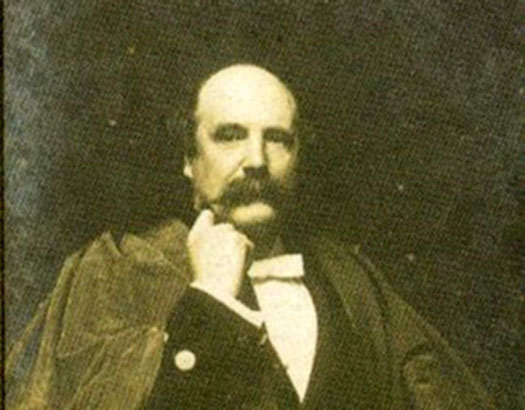
Alexander Williams RHA was the best-known artist in the Graphic Cruisers Club. A taxidermist of international repute, he was also a noted ornithologist, and his interest in maritime subjects was matched by his enthusiasm for landscape. He was one of the first artists to "discover" Achill Island in the west of Ireland, and in time he created a remarkable garden there in a three years project in which he personally worked shoulder-to-shoulder with the build team.
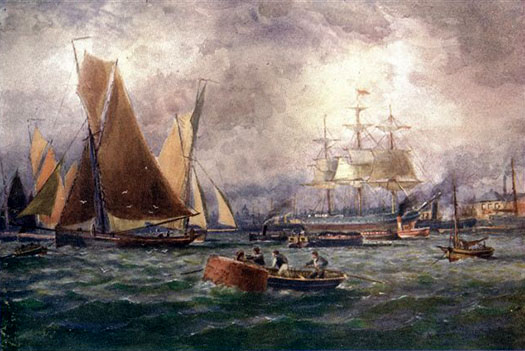
A classic Alexander Williams portrayal of the trawlers of Ringsend with other shipping in the Liffey. Thanks to research by Cormac Lowth, we are now aware of how the style of the Ringsend sailing trawlers came about through links, between 1818 and the 1914 outbreak of Great War, with the pioneering fishing port of Brixham in Devon, which was the most technologically advanced fishing port in Europe in the mid 1800s. Courtesy Cormac Lowth
They were larger than life, every last one of them, and Prescott and Williams in particular were renaissance men who could turn their hand to any number of creative projects at a time when life around Dublin was fairly buzzing for those with the energy and interest to enjoy it.
And there were links to other aspects of Dublin waterfront life which have a further resonance. Back in January, I'd to give one of the supper talks at the National YC in Dun Laoghaire, and on this occasion the topic was John B Kearney (1879-1967), the Ringsend-born yacht designer and boatbuilder who was the club's Rear Commodore for the last 21 years of his life.
You need some sort of special little link to bring these talks to life, but fortunately I remembered that there's a fine big Alexander Williams painting of sailing trawlers at Ringsend in the NYC's dining room. I didn't know its date as we headed round the bay on the night of the talk, but we struck gold. It was dated 1890.

The Brixham style in Ringsend was best exemplified by the largest trawler built in the Dublin port, the St Patrick (right) of 53 tons built in 1887 in the Murphy family's boatyard beside the mouth of the River Dodder. The Murphy family also owned and operated the St Patrick in her fishing, and when John Kearney built his renowned yachts, the earliest (and best) of them were built in a corner of Murphy's Boatyard - the Ainmara in 1912, the Mavis in 1925, and the Sonia in 1929. Photo courtesy Cormac Lowth
Williams was so fond of the Ringsend scene that he lived there for a while in Thorncastle Street where John B Kearney was born, and of course the painter subsequently sailed regularly from the old port in the Iris, and would have over-nighted at Sandefjord too. He is in fact the definitive Ringsend maritime artist, and the picture in the NYC expresses this. And as it includes some of the Ringsend waterfront, we could say that it also includes John B Kearney, for in 1890 the precocious eleven-year-old Ringsend schoolboy was in the boatyards as much as possible, as he had already stated in his quietly stubborn way that his ultimate ambition was to be a yacht designer.
Not a boatbuilder or a shipwright or a harbour engineer, which is nevertheless what he was until he retired in 1944. But upon his leaving the day job - in which he'd been highly respected - he then devoted all his energies to what he had been doing all his life in his spare time. And with his death aged 88 in 1967, his gravestone in Glasnevin cemetery said it all: John Breslin Kearney (formerly of Dublin Port & Docks Board) Yacht Designer.
And if you wonder how on earth we have come to a consideration of John Kearney's memorial stone in an article which purports to be about the social glues which keep boat partnerships in good order, believe me when you get involved with the boys of the Graphic Cruisers Club you never know where it's all going to end.
We've already discovered that in later life Alexander Williams devoted much energy to his garden in Achill while at the same time continuing to be an active member of the Royal Hibernian Academy in Dublin. As for George Prescott, he too broadened his already extensive interests, and in his eighties he was much into amateur opera production, even being so deeply involved as to paint the stage scenery himself.
Dublin too was expanding, so he accepted that a move eastward was needed if he was going to be able to continue to commune directly with his beloved sea. So he left Sandefjord, and the final decades of his wonderful life were spent at his new home at The Hermitage on Merrion Strand. Needless to say, Alexander Williams provided him with a painting of The Hermitage which captured the then unspoilt nature of a place you'd scarcely recognize today.
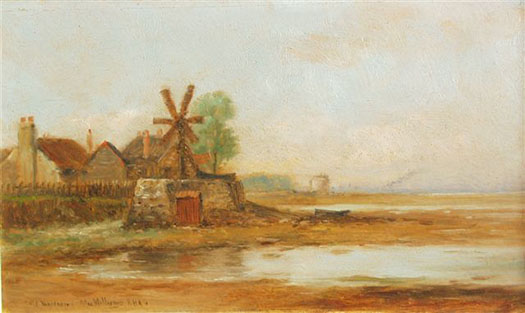
The Hermitage on Merrion Strand, George Prescott's last home as portrayed by Alexander Williams. Courtesy Cormac Lowth
Historic Trophy for South Pacific Dream Cruise
Fergus and Kay Quinlan live in the Burren in County Clare, and in 1997 they launched the steel van de Stadt 12-metre cruiser Pylades, which they'd built themselves. They've made several voyages and have been in the Irish Cruising Club's award list before. But at the ICC's AGM in the National YC on February 18th they deservedly got the big one, the Faulkner Cup, for the first stage of a global circumnavigation which began from their home port of Kinvara in the summer of 2009, and a year later they'd reached Tahiti.
Their cruise continues, so the award was made in absentia. Adjudicator Brian Cudmore of Cork made the point that their informative log included much general and often entertaining information, and it becomes even more interesting the further you got into it, so he's keenly anticipating the next inmstalment.
The Strangford Cup for an alternative best cruise could not have been more different, both in location or boat type. The 44ft Young Larry may have been built of steel in 1995, but she was based fairly precisely on the design of a gaff cutter built in 1907. And though the rig has been made more manageable through being a yawl, even the mizzen is gaff-headed, while the main sets a topsail. Not the most-easily handled rig for challenging seas, you might well think, but Maire Breathnach (originally from Dungarvan) and her partner Andrew Wilkes, crewed by Maire's niece Sibeal Turraoin, took Larry Og – which looks for all the world like a smaller Asgard I – right through the Northwest Passage to Alaska, an extraordinary one-season achievement.
The ICC members logged some other notable Atlantic voyages, with Michael Coleman of Cobh, a Port of Cork Pilot before he got the free bus pass, making a fine Atlantic triangle to the Azores, then Newfoundland, and so home to Cork, visiting many islands with his well-found 1988 Oyster 53 Oyster Cove. It was all done with a crew of average age 66, senior member Tom Noonan aged 76, and worthy winners of the Atlantic Trophy.
Over the years since its foundation in 1929, the Irish Cruising Club has become the trustee and adjudicator of many trophies, twenty in all, and two of them were special presentations in 2010. The Donegan Memorial Trophy went to Ruth Heard, an ICC member since 1967. She has cruised both to the Azores and Iceland, but is honoured this year in celebration of her remarkable contribution to the rebirth of the inland waterways, and to mark the re-opening of the Royal Canal. Ruth Heard was on the crew of Harklow, the last boat to transit the Royal in 1954 before its half century of official closure which was gloriously reversed in 2010.
And once upon a time, the ICC was the organiser of Ireland's Admiral's Cup campaigns. Though many members still race offshore as individuals, the club has long since focused totally on cruising. But it has a general trophy, the John B Kearney Cup for Services to Irish Sailing, and for 2010 it was awarded with acclamation to the successful Irish Commodore's Cup Team.
- Faulkner
- Cruise
- Cruising
- Cup
- Club
- Quinlan
- Kay
- Fergus
- ICC
- National
- yacht
- cub
- YC
- Cudmore
- Cork
- Breathnach
- Alaska
- Asgard I
- Strangford
- Burren
- Pylades
- Northwest
- Passage
- Wilkes
- Sibeal Turraoin
- Coleman
- Atlantic
- Cobh
- Newfoundland
- Oyster Cove
- Oyster
- Donegan
- trophy
- Ruth Heard
- John B Kearney
- Cup
- Commodore's
- gaff



























